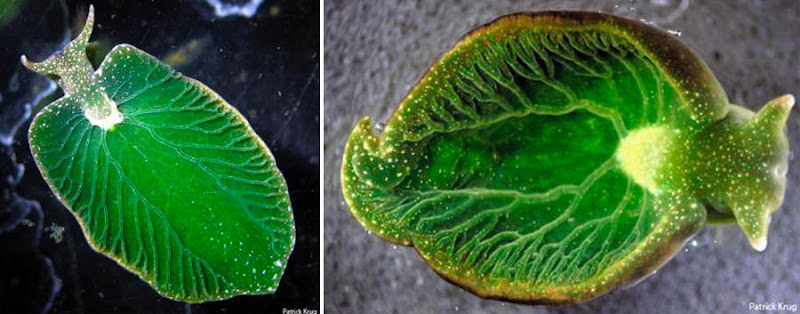Republished by Blog Post Promoter
Wildly bizarre half-plant/half-animal creature – with a lovely name “Eastern Emerald Elysia”
This beautiful leaf-shaped sea slug Elysia chlorotica lives in shallow pools along Atlantic coast of North America, eats algae with gusto – one meal is enough for its lifetime! – and by using photosynthesis like any other plant, shatters the most basic definition between the “animal” and “plant” kingdoms.


(images credit: PNAS, via, Nicholas E. Curtis and Ray Martinez, via)
It may not be “easy being green”, but for this slug it turned out to be highly efficient!
This is the ONLY natural example of genes shared between the living kingdoms of “plants” and “animals”
Shaped like a leaf? Check. Totally colored green? Check, although the young slugs are still colored brown until they eat their first “green” meal… but right after that, they’re ready to make pigment chlorophyll a all by themselves for the rest of their lives!
One thing about Elysia chlorotica, “a sea slug that has stolen enough genes to become the first animal shown to make chlorophyll like a plant” (via)… They don’t just use chloroplasts from the algae they eat – this phenomenon, though rare, is known as kleptoplasty. What’s more, they seem to have the particular genes that make them able to keep processing these chloroplasts in a consistent and sustainable way:

(images credit: Patrick Krug Cataloging Diversity in the Sacoglossa LifeDesk)
What sort of surprises can be found in a humble shallow pool? Turns out, quite an awful lot! Elysia chlorotica likes to inhabit “salt marshes, tidal marshes, pools and shallow creeks, at depths of 0 m to 0.5 m”. All this should serve as a good encouragement to look closer into swamps and marshes (provided they are not haunted by any mad scientist apparitions, or the feral Hounds of the Baskervilles). There is positively astonishing microscopic biodiversity to be discovered all around your feet!”
Via Dark Roasted Blend

 PARIS—At a press conference Tuesday, the World Heritage Committee officially recognized the Gap Between Rich and Poor as the “Eighth Wonder of the World,” describing the global wealth divide as the “most colossal and enduring of mankind’s creations.”
PARIS—At a press conference Tuesday, the World Heritage Committee officially recognized the Gap Between Rich and Poor as the “Eighth Wonder of the World,” describing the global wealth divide as the “most colossal and enduring of mankind’s creations.”